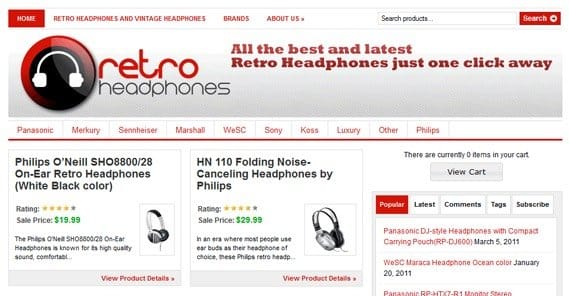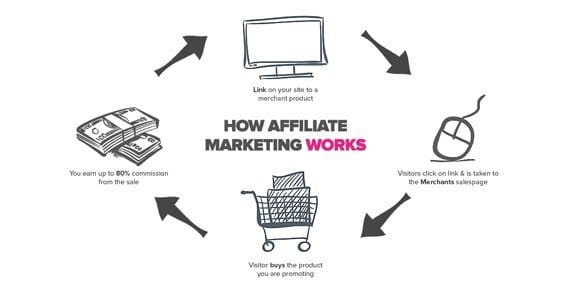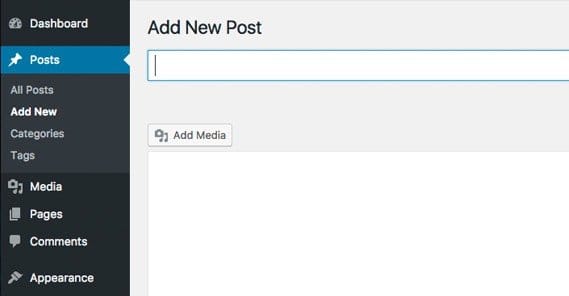How to Build an Affiliate Site with Little to No Experience

Affiliate marketing is a great way to make money online, and it doesn’t necessarily take a ton of experience or a ton of investment. I’ve decided to put together a basic tutorial on going from nothing to a functional affiliate site with no experience in affiliate marketing. I will, however, assume you have at least a little experience with the internet in general. I’ll be glossing over most topics, and linking to more detailed posts on each subject for further reading. Gloss over the sections you know and understand, read more on the ones you don’t, and get to making money!
Step 1: Understand How Affiliate Marketing Works
Affiliate marketing is a way to make money essentially being an advertiser for another company. You create a website and content about products, recommending those products to your audience. You work to get an audience to your site, to see those recommendations. Your audience clicks your links and goes to the store where they can buy those products, and makes their purchase. The store notices that the traffic came from your site and pays you a cut of the sale, a fixed bonus, or some other agreed-upon payment.
There are a ton of different networks for affiliate marketing, with a wide range of different perks and benefits. We covered some of the best here. For this specific post, we’ll primarily be talking about Amazon, because it’s incredibly easy to set up and run. Plus, with Amazon, you have the added benefit of getting a cut of the sale on everything the user buys, not just what you promote.
Let’s break things down. To have a successful affiliate site, you need:
- Content that attracts traffic.
- Affiliate offers that are attractive to your traffic.
- A general theme for your traffic.
- Promotion to increase your traffic.
Everything comes down to traffic, so that’s what a lot of affiliate marketing is focused on. You want to do everything you can to get as many people as possible – who are interested in your niche – to visit your site.
Generally, this means getting a site to the first page of Google for a selection of relevant keywords. Getting to that first page spot will mean a lot of time invested in SEO work, so strap in.
Step 2: Pick a General Niche
The first thing you’re going to have to do is pick a niche. A niche is a subset of a market, broad enough to give you options to promote, but narrow enough to attract a specific type of task-oriented searchers. See, you don’t care about being a huge hub of information; you’re looking to attract people who are actively seeking to buy something in your niche.
Let’s look at three example niches.
- Home Appliances
- Washing Machines
- Stainless Steel Washer/Dryer Combo Machines
The first is far, far too broad to make a good niche. Someone looking for washing machines might be satisfied when they land on your site, but someone looking for a gas oven might not find any relevant content or links. You would also have to compete with everyone from BestWashingMachines.com to Sears.
The second is just about right. Washing machines have a lot of variety, so you can sell different types of machines to different people, but it’s not so broad that you lose focus. Of course, washing machines aren’t a great product to sell online – people like to see their appliances in person, or at least not have to pay shipping on large, heavy machines – but you get the idea.
The third one is far too narrow. You might have a high conversion rate, since you’re only attracting people who want that exact kind of machine, but your target audience is very small.
Your niche should be something that you can either fake passion about, or that you are passionate about. Or it’s something you can pay someone to be passionate about, but that’s another story, for step five. For now, go ahead and read this post about choosing a niche. It should get you started on picking the general theme of your business.
Step 3: Register for an Affiliate Network
There’s no limit to the number of affiliate networks you can sign up for, but you can’t pump your site full of affiliate links or Google will penalize you. In general, Amazon Affiliates is the best introductory affiliate network. Their pay is a little low, but it works on a performance basis, growing as you grow. It also gives you access to everything on Amazon, so it works pretty well regardless of niche.
I will say this; if your chosen niche isn’t well represented on Amazon, or if you want to go into an esoteric business model, feel free to sign up for a different network. For example, if you want to promote subscription services or courses – something that has a recurring commission structure – you might choose one of these networks.
The Amazon program is just a good, basic program that has a lot of tools to help make your life easier. Their reporting is fairly robust, they’re accurate with their measurements and their conversion tracking, and they’re a trusted name throughout the web. You also have the benefit of, as I mentioned, being able to earn based on any referred purchase, regardless of what it is. If you set up a referral code for a $5 pen and someone decides they don’t want it, but they do want this $500 TV, you’ll get a commission on that TV sale. You can sign up for the Amazon Associates program here.
Step 4: Set Up a Website
Next up, you need to set up a website. There are a million tutorials for setting up a site, but honestly, you don’t need much more than a basic WordPress site with a decent looking theme. You can go all-in on custom themes and fancy layouts later, for sequential projects or a later site redesign.
You can break down setting up a website into several discrete aspects:
- URL
- Web Hosting
- Content Management System
- Theme and Plugins
Your URL is tricky. You have to pick something that is relevant to your niche, but Google doesn’t like exact match domains. The “bestwashingmachines.com” example is actually not a very good idea, because it’s an exact match keyword, and anyway people don’t really trust those style sites these days. You want something like TheWasherReview.com or something similarly brandable. You also need to get a .com. If your desired URL is already taken as a .com, not only will you find it harder to rank, but you have to compete with whoever owns it.
Web hosting can come from anywhere you want. Pay for some decent hosting – it’s cheap these days – so you can guarantee uptime more than anything else. You won’t be doing much from the host side once your site is set up, unless you need to update your CMS or you get hacked. Dreamhost, Host Gator, 1&1, InMotion, and Hostwinds are all good choices.
Your CMS is going to be WordPress. Just go to www.wordpress.org and download it, follow the steps to install it on your hosting package, and get set for the customization. You don’t even need to do that much if you get a web host that sets up WordPress for its customers, for that matter.
For a theme, you want something that instills confidence and looks good. It’s going to be a pretty personal decision, so take your time to explore the options. Anything from Elegant Themes is going to be pretty good, but be warned; they can be expensive. You can also find plenty of lists like this about “top affiliate themes” and the like.
As for plugins, you’re going to want at least a handful. I recommend analytics, something for security, Yoast SEO for the onsite marketing, something for social sharing buttons, and whatever else you feel you need. The most important one is Yoast, for our purposes.
Step 5: Create Content
Once you have a site set up, you need to create content. Content is the lifeblood of your website. It’s what attracts people, it’s what’s ranked in Google search, and it’s where you put your affiliate links.
You can write content yourself, or you can pay a ghostwriter to create it for you. It’s up to you and how much of a personal touch you want to put into it. Well, that, and how good of a writer you are.
It doesn’t matter whether or not you hire a writer to do the actual work; you need to spend time researching keywords for your niche. Keywords in general are going to be the single most important aspect of your entire project.
You need to find keywords that fit these criteria:
- They need to have enough search volume to send you a reasonable amount of traffic once you rank.
- They need to have low enough competition that you have a reasonable chance of ranking on the first page of Google, even if you can’t hit number one.
- They need to have a “purchase action” driving them. A keyword about why washing machines are not environmentally friendly might drive traffic, but it won’t generate sales.
- They need to be closely related to your product. If you’re driving people to your site with keywords about washing clothes in general, they might be looking for info on detergents, hand washing, fabric life, who knows what else. It’ll be hard to sell washing machines to those people.
I’m going to be honest here; you’re going to be putting a lot of work into researching keywords. This is one area in web writing where I still promote the use of specific keywords over general themes. We’ve written a few posts you can read for more information.
Once you’ve found your keywords you need to create content. You can play this somewhat by ear, but remember; you’re trying to sell your products. That means you need to write content that will be relevant to people looking to buy. Reviews, comparisons, and tutorials are all good here. One scheme I’ve seen is to populate your starting site with:
- Five reviews, one for each of the five most popular, best selling items in your niche.
- Three tutorials on how to perform a niche-related task, like “how to install a new washing machine.”
- Three list posts, like “the top 10 washing machines of 2016.”
All posts should be at least 1,000 words in length, stretching to 2,000 or so for larger posts. All of them should have affiliate links for your recommended products. Each of them should target a different, unique keyword, in part so you can measure which perform the best, and in part so you can cover as many bases as possible.
Step 6: Promote Your Site
Once your site and your content is up, you have to promote it. There are a ton of options to do this, free and paid. In part, you’ll want to optimize your SEO on-site through Yoast for all of your posts. This will help Google rank you higher as a starting point.
From there, you can share and promote yourself on Facebook, Twitter, and various communities dedicated to your products. You can even promote yourself on marketing boards, just by asking for help, though they aren’t likely to be buyers. You can buy ads through Facebook and Google, spending money to make money.
Promoting an affiliate site is such a large topic I don’t have any one post to link you to as a guide. You’ll simply have to find tutorials for the means of promotion you want to pursue.
Step 7: Change, Invest, and Grow
At this point, just having a site with some basic promotion should get you some traffic and, ideally, some sales. With this money and with the information you get from your analytics, you can iterate your site. Post new content, around one post per week, to expand your target keywords and create more opportunities to sell different products. Use some of your profits to invest in paid advertising for better keywords. Expand your site and grow it, until it reaches a point where you can be satisfied.
 ContentPowered.com
ContentPowered.com










